1995 Oldsmobile Cutlass Supreme check engine light
[x] Cancel search: check engine lightPage 68 of 340
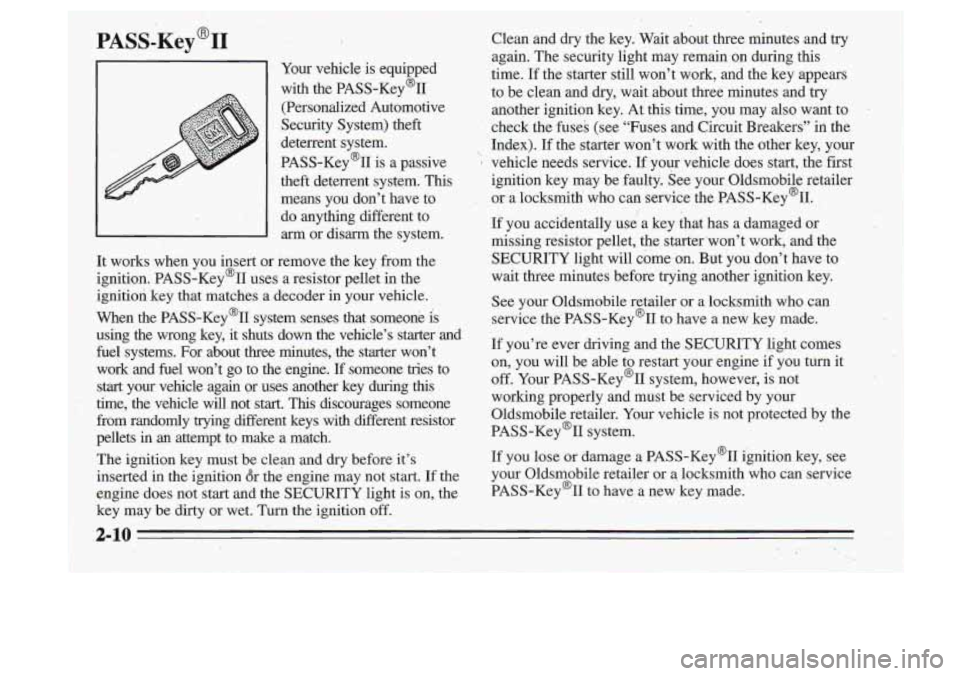
PASS-Key@II
r
J
Your vehicle is equipped
with the PASS-Key’II (Personalized Automotive
Security System) -theft
deterrent system.
PASS-Key’II is a passive
theft deterrent system. This
means you don’t have to
do anything different to
arm or disarm the system.
It works when you insert or remove the key from the
ignition. PASS-Key’II uses a resistor pellet in the
ignition key that matches a decoder in your vehicle.
When the PASS-Key@II system senses that someone
is
using the wrong key, it shuts down the vehicle’s starter an\
d
fuel systems. For about three minutes,
.the starter won’t
work and fuel won’t go to the engine. If someone tries
to
start your vehicle again Or uses another key during this
time, the vehicle will not
start. This discourages someone
from randomly trying different keys with different resistor
pellets in
an attempt to make a match.
The ignition key must be clean and dry before it’s
inserted in the ignition dr the- engine may not start. If the
engine does not start and the SECURITY light is on, the
key may be dirty or wet. Turn the ignition off. Clean and dry the key. Wait about three minutes and try
again. The security light may remain on during this
time. If the starter still won’t work, and the key appears
to be clean and dry, wait about three minutes and try
another ignition key. At this time, you may also want to
check the fuses (see “Fuses and Circuit Breakers” in the\
Index). If the starter won’t work with the other key, your
q vehicle needs service. If your vehicle does start, the first
ignition key may be faulty. See your Oldsmobile retailer
or a locksmith who can service the PASS-Key’II.
If you accidentally use a key that has a damaged or
missing resistor pellet, the starter‘won’t work, and the SECURITY light will come on. But you don’t have to
wait three minutes before trying another ignition key.
See your Oldsmobile retailer or a locksmith who can
service the PASS-Key@II
to have a new key made.
If you’re ever driving and the SECURITY light comes
on, you will be able to restart your engine if you turn it
off. Your PASS-Key’II system, however, is not
working properly and must be serviced by your
Oldsmobile retailer. Your vehicle is not protected by the
PASS-Key@II system.
If you lose or damage a PASS-Key@II ignition key, see
your Oldsmobile retailer or a, locksmith who can service
PASS-Key@II to have a new key made.
2-10
.. .
Page 103 of 340
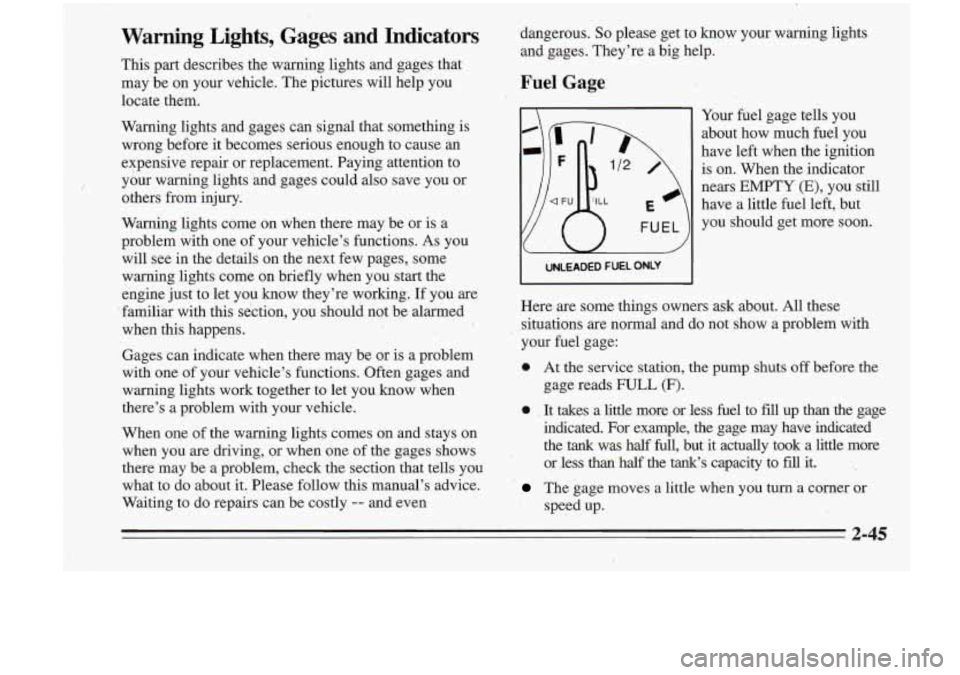
Warning Lights, Gages and Indicators
This part describes the warning lights and,gages that
may be
on your vehicle. The pictures will help you
locate them.
Warning lights and gages can signal that something
is
wrong before it becomFs serious enough to cause an
expensive repair or replacement. Paying attention to
your warning.lights and gages could also save you or
others from injury.
Warning lights come on when there may be or is a
problem with one of your vehicle’s functions.
As you
will see in the details on the next few pages, some
warning lights come on briefly when you start the
engine just to let you know they’re working.
If you are
‘familiar with this section, you should not be alarmed
when this happens.
Gages can indicate when there may be or is a problem
with one-of your vehicle’s functions. Often gages and
warning lights work together to let you know when
there’s a problem with your vehicle.
When one
of the warning lights comes on and stays on
when you are driving, or when one of the gages shows
there may be a problem, check the section that
tells you
what to do about
it. Please follow this manual’s advice.
Waiting to do repairs can be costly
-- and even dangerous.
So please
get to know your warning lights
and gages. They’re
a big help.
Fuel Gage
Your fuel gage tells you
about how much fuel
YOU
have left when the ignition
is on. When the indicator
nears
EMPTY (E), you still
have
a little fuel left, but
you should get more soon.
UNLEADED FUEL ONLY I
I
Here are some things owners ask about. All these
situations are normal and do not show a problem with
your fuel gage:
0 At the service station, the pump shuts off before the
gage reads
FULL (F).
0 . It takes a little more or less fuel to fill up than the gage
indicated. For example, the gage may have indicated
the
tank was half full, but it actually took a little more
or less
than half the tank‘s capacity to fill it.
The gage moves a little when you turn a corner or
speed up.
2-45
Page 108 of 340
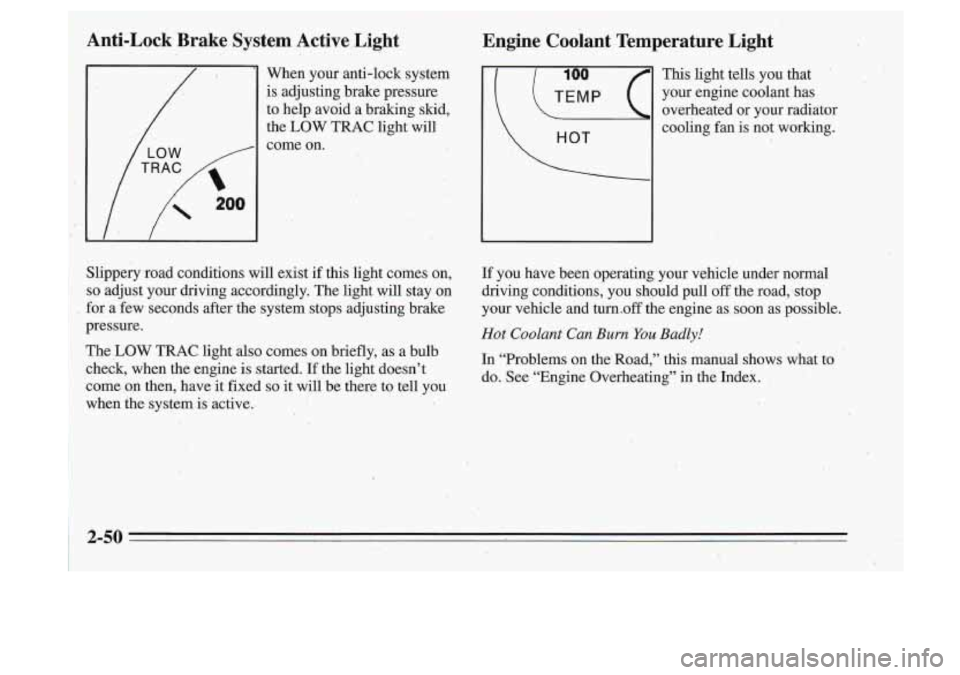
Anti-Lock Brake System Active Light
When your anti-lock system
is adjusting brake pressure
to help avoid a braking skid,
the LOW TRAC light will
come on.
Slippery road conditions will exist if this light comes on,
so adjust your driving accordingly. The light will stay on
for a few seconds after the system stops adjusting brake
pressure.
The LOW TRAC light also comes on briefly, as a bulb
check, when the engine is started. If the light doesn’t
come on then, have it fixed
so it will be there to tell you
when the system is active.
‘ This light tells.you that
your engine coolant has
, overheated or your radiator
cooling fan is not working.
If you have been operating your vehicle under normal
driving conditions, you should pull
off the road;stop’
your vehicle and turn.off the engine as soon as possible.
Hot Coolant Can Burn You Badly!
In “Problems on the~Road,” this manual shows what to
do. See “Engine Overheating”
in the Index.
2-50
Page 110 of 340
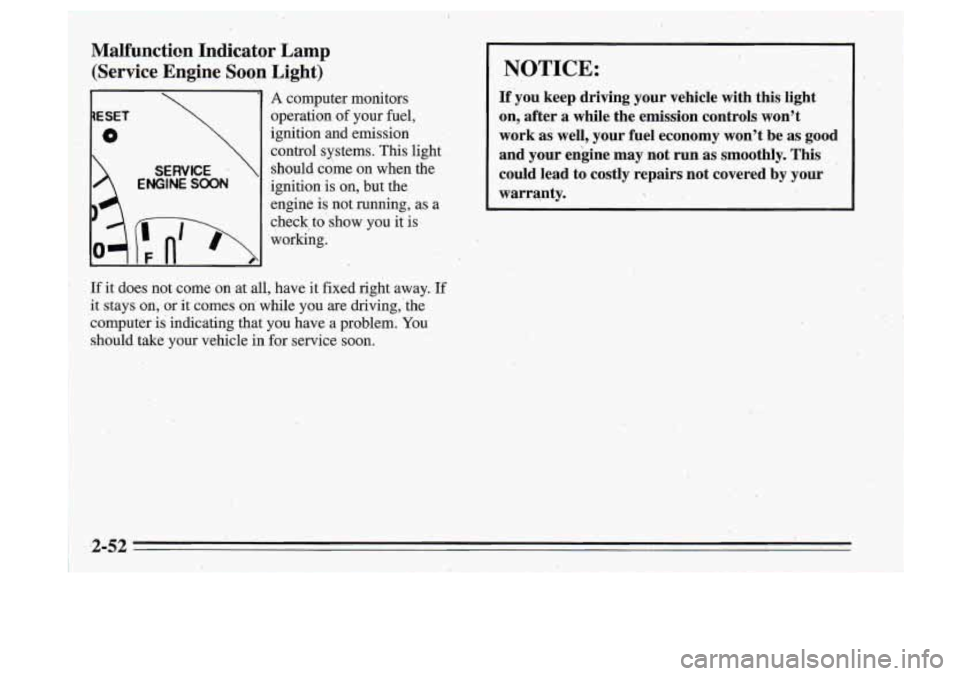
~ Malfunction Indicator Lamp
(Service Engine Soon Light)
1ESET
0
SERVICE
ENGINE SOON
1 A computer monitors
operation of your fuel,
ignition and emission control systems. This light
should come on when the
ignition
is on, but the
engine
is not running, as a
check, to'show you it is
working.
If it does not come
on at all, have it fixed right away. If
it stays on, or it comes on while you are driving,'the
computer is indicating that
you have a problem. You
should take your vehicle in for service soon.
,I.
NOTICE:
If you keep driving your vehicle with this light
on, after a while the emission controls won't
work as well, your fuel economy won't
be as good
and your en'gine may not run as smoothly. This
could lead to costly repairs not covered by your
warranty.
Page 112 of 340

.(I
Low Oil Level Light
Your engine is equipped’
wiih
an oil level monitoring
system. When the ignition
key is turned on, the
LOW
V
LOW.O(L
LEVEL
OIL LEVEL light will
briefly flash.
If the light
‘does not flash, have it fixed
I 8 - -1 so it will be ready to warn
I n
I ‘A ‘n-1 , .
you if there’s a problem.
- ..
Security Light
I
RESET
80
This light will come on
when you
turn the key to
start and stay on until the
vehicle starts.
It will also
come on and stay on if your
key is too dirty or wet for
the PASS-Key% system to
read the resistor pellet.
,
If the light stays on,, stop the vehicle on a level surface
and turn the engine
off. Check the oil level using the
engine oil dipstick. (See “Engine Oil” in the Index.) If
thti light does not flash, have
the low oil level sensor
system repaired
so it will be ready to warn you if there’s
a problem.
The
oil level monitoring system only checks oil level
during the brief period between key on and engine
crank. It does not monitor engine oil level when the
engine is running. Additionally,
an oil level check.is
only performed if the engine has been turned
off for- a
considerable period
of time, allowing the oil normally in
circulation to drkn back into the oil pan.
If the resistor pellet is damaged or missing, the light will
flash.
If you’re driving and the security light comes on
and remains on, your PASS-Key’II system is not
working pro erly. Your vehicle is not protected by
PASS-Key
2 11, and you should see your retailer.
2-54
t
Page 134 of 340
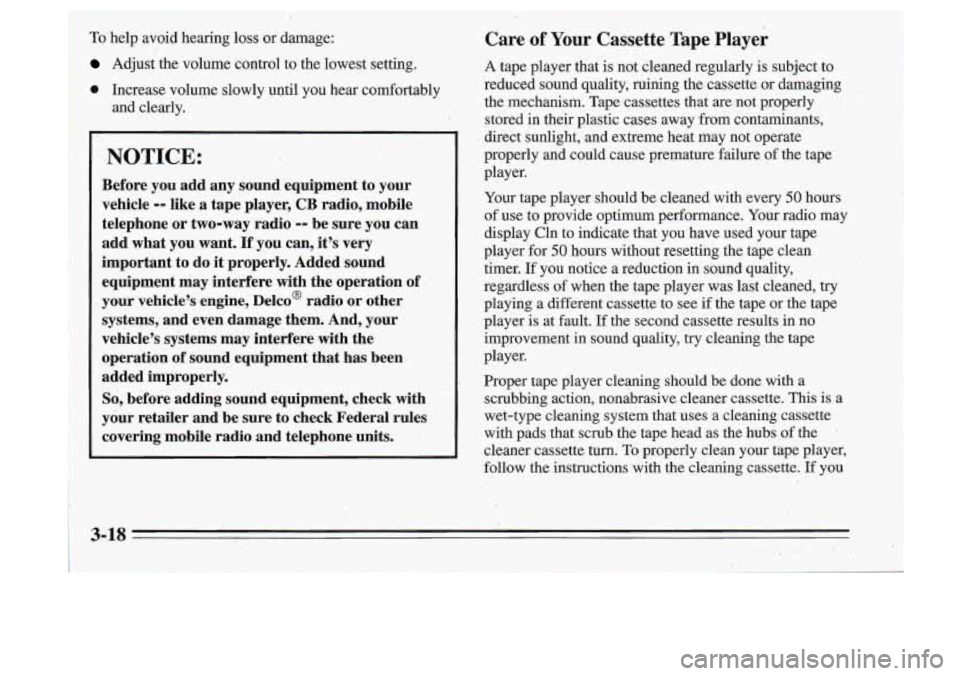
To help avoid hearing loss or damage:
Adjust the volume control to the lowest setting.
0 Increase volume slowly until you hear comfortably
and clearly.
NOTICE:
Before you add any sound equipment to your
vehicle
-- like a tape player, CB radio, mobile
telephone or two-way radio
-- be sure you can
add what you want.
If you can, it’s very
important to do it properly. Added sound
equipment may interfere with the operation of
your vehicle’s engine, Delco@ radio or other
systems, and even damage them. And, your
vehicle’s systems may interfere with the
operation of sound equipment that has been
added improperly.
So, before adding sound equipment, check with
your retailer and be sure to check Federal rules
covering mobile radio and telephone units.
~
Care of Your Cassette Tape Player
A tape player that is not cleaned regularly is subject to
reduced sound quality, ruining the cassette or damaging the mechanism. Tape cassettes that are not properly
stored
in their plastic cases away ,from contaminants,
direct sunlight, and extreme heat may not operate
properly and could cause premature failure
of the tape
player.
Your tape player should be cleaned with every
50 hours
of use to provide optimum performance. Your radio may
display Cln to indicate that you have used your tape
player for
50 hours without resetting the tape clean
timer. If you notice a reduction in sound quality,
regardless
of when the tape player was last cleaned, try
playing a different cassette to see if the tape or the tape
player is at fault. If the second cassette results
in no
improvement in sound quality, try cleaning the tape
player.
Proper tape player cleaning should be done with a
scrubbing action, nonabrasive cleaner cassette. This is a
wet-type cleaning system that uses a cleaning cassette
with pads that scrub the tape head as the hubs
of the
cleaner cassette turn.
To properly clean your tape player,
follow the instructions with the cleaning cassette. If you
I
Page 157 of 340
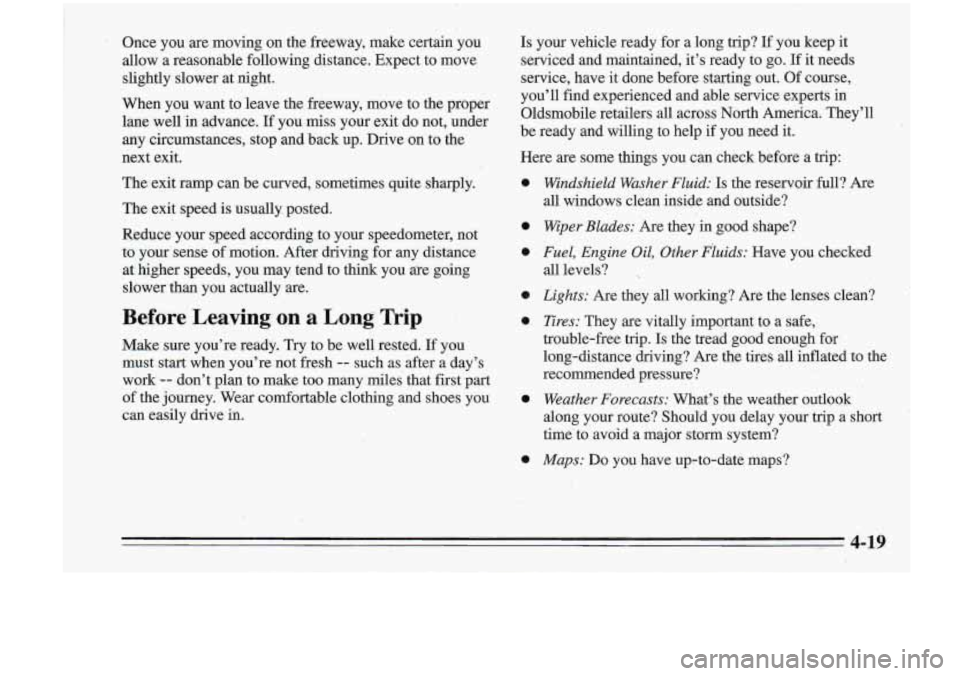
3 Once you are m,oving on the freeway, make certain you
allow a reasonable following distance. Expect to move
slightly slower at night.
When you want to leave the freeway, move to the proper
lane well in advance.
If you-miss your exit do not, under
any circumstances, stop and back up. Drive on to the
next exit.
The exit ramp can be curved, sometimes quite sharply.
The exit speed is usually. posted.
Reduce your speed according to your speedometer, not
to your sense of motion. After driving for any distance
at higher speeds, you may tend to think you are going
slower’than you actually are.
Before Leaving on a Long- Trip
Make sure you’re ready. Try to be well rested. If you
must
start when you’re not fresh -- such as after a day’s
work
.-- don’t plan to make too many miles that first part
of the journey. Wear comfortable clothing and shoes you
can easily drive in. Is your vehicle ready
for a long trip? If you keep it
serviced and maintained, it’s ready to go.
If it needs
service, have it done before starting out. Of course,
you’ll find experienced and able service experts in
Oldsmobile retailers all across North America. They’ll
be ready and willing to help
if you need it.
Here are some things you can check before a trip:
0
0
0
0
0
0
0
,Windshield Washer Fluid: Is the reservoir full? Are
all windows clean inside and outside?
Wiper Blades: Are they in good shape?
Fuel, Engine Oil, Other FZuids: Have you checked
all levels?
,
Lights: Are .they all working? Are the lenses clean?
Tires: They are vitally important to a safe,
trouble-free trip. Is the tread gaod enough for
long-distance driving? Are the tires all inflated to the
recommended pressure?
Weather Forecasts: What’s the weather outlook
along your route? Should you delay your trip a short
time‘to avoid a major
storm system?
Maps: Do you have up-to-date maps?
,
Page 214 of 340
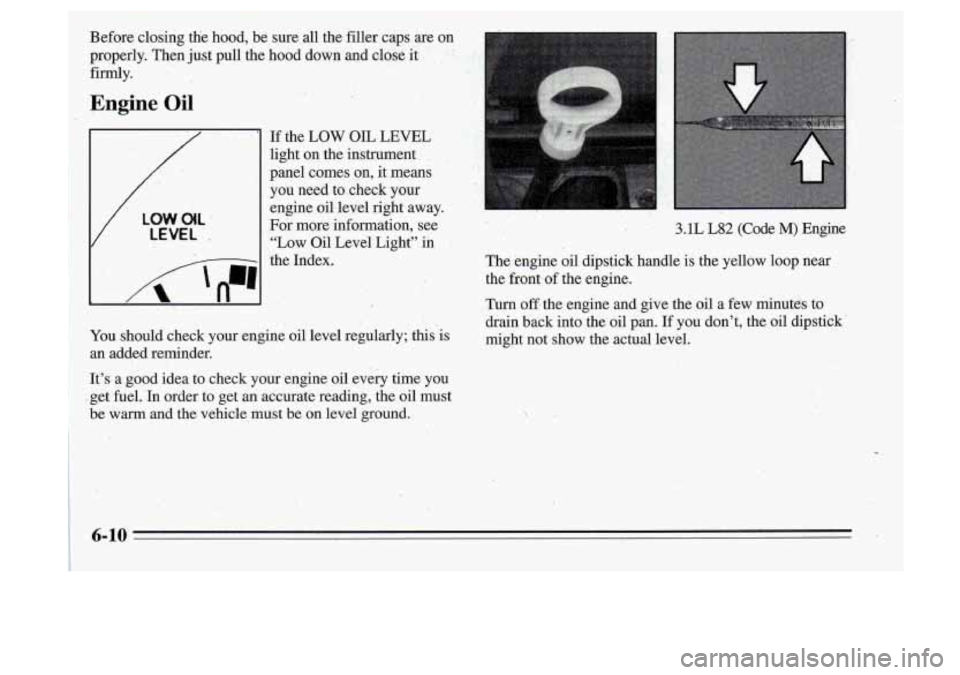
Before closing the hood, be sure all the filler caps are on
properly. Then just pull the hood down and close it
firmly.
Engine Oil .. , ‘I: ~. ’. .I
LOW OIL
LEVEL
If the LOW OIL LEVEL
light on the instrument
panel co-mes on, it means
you need to check your
engine oil level right away.
For more information, see “Low Oil Level Light” in
the Index.
You should check your engine oil level regularly; this is
an added reminder.
It’s a
good idea to check your engine oil every time you
get
fuel. In order to get an accurate reading, the oil must
be warm
and the vehicle must be on level ground.
c
,3.1L.L82 (Code M) Engine
The engine
oil dipstick handle is the yellow loop near
the front of the engine.
Turn. off, the engine and give the oil a few minutes to
drain back into the oil pan. If you don’t, the oil dipstick ’
might not show the actual level.